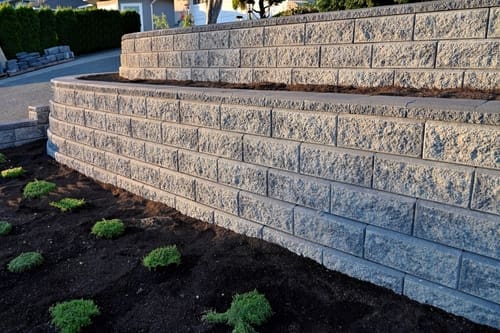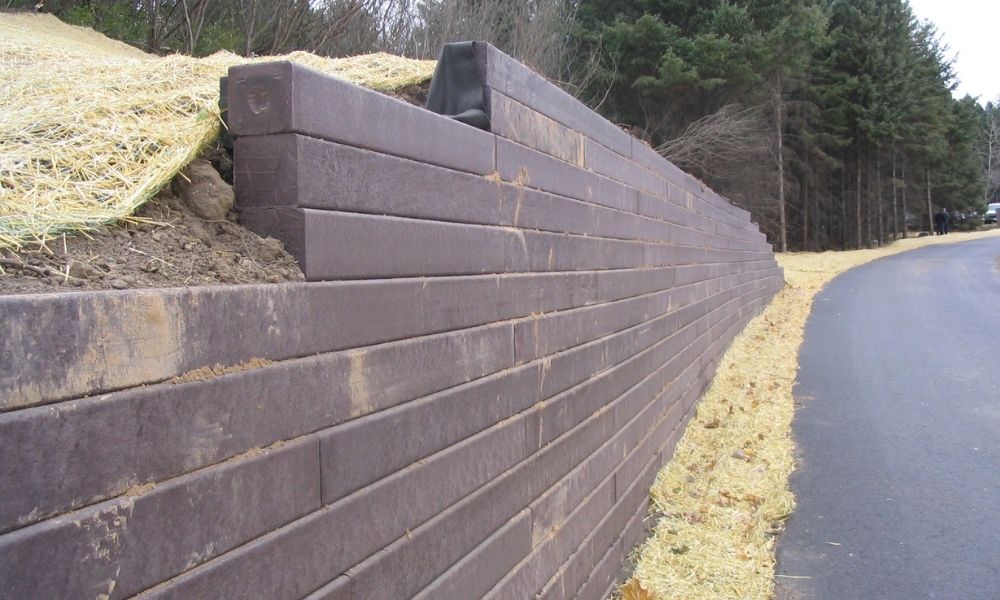Key Factors To Consider for Structure Effective Retaining Walls in Your Backyard
When you're considering building a retaining wall in your yard, it's essential to assume concerning a number of essential elements. The wall surface's purpose, the products you'll use, and the certain dirt conditions can all affect its efficiency and longevity.
Comprehending the Purpose of Your Retaining Wall
When you believe concerning building a keeping wall surface, consider its main function: maintaining soil and stopping disintegration. Retaining walls provide vital assistance for sloped landscapes, assisting to keep dirt stability. You'll discover they're important in areas where water overflow could or else remove soil, bring about expensive repair services and landscape damages.
By holding back planet, these walls develop level surface areas for yards, patio areas, or paths. This not just enhances your yard's visual appeals however additionally advertises better drainage, minimizing water merging in undesirable locations. If you're managing steep slopes, a well-constructed retaining wall can stop landslides, making certain safety and security for you and your building.
Inevitably, comprehending the function of your retaining wall will direct your design decisions and help you create a practical, resilient structure that meets your needs. So, take a moment to evaluate your landscape; it'll settle over time.
Selecting the Right Materials
When choosing products for your retaining wall surface, you'll intend to consider toughness, appearances, and price. Each variable plays an essential duty in guaranteeing your wall stands the test of time while looking excellent and suitable your budget plan. Let's explore just how to make the most effective options for your project.
Product Longevity Elements
Choosing the right products is important for the longevity and performance of your retaining wall, because their toughness directly influences the wall surface's ability to hold up against environmental tensions. Begin by considering your neighborhood climate; materials like concrete and rock withstand moisture and temperature level variations well. If you reside in an area susceptible to heavy rainfalls, choose products with good drain buildings, like crushed rock or porous blocks, to avoid water buildup.
In addition, think of the soil conditions on your building. Some materials do better in particular dirt types, so it is essential to match them appropriately. Be conscious of potential wear from insects or erosion. Picking sturdy products assurances your retaining wall surface stands solid, securing your yard for several years to come.
Visual Layout Selections
Resilient materials not just ensure your retaining wall's structural stability however likewise play a vital function in its visual allure. Don't neglect concerning the wall's form-- curved walls can produce a softer appearance, while straight lines can really feel extra structured. By very carefully selecting products that line up with your aesthetic vision, you'll boost your outside space while guaranteeing your wall stands solid against the components.
Cost-Effectiveness Analysis
Selecting the appropriate materials for your retaining wall surface isn't just concerning visual appeals; it's also essential for your budget plan. When choosing products, consider both in advance prices and lasting durability. Concrete blocks may be pricier originally, but their durability can conserve you cash on repair services. On the various other hand, lumber can be more budget-friendly however might need substitute faster.
Do not neglect to factor in maintenance prices. Some products, like all-natural rock, can include charm and need less maintenance, while others could require routine therapies
Ultimately, consider the benefits and drawbacks of each alternative versus your budget and the wall's intended purpose. Spending sensibly in products now can protect against pricey concerns down the roadway. Pick products that stabilize price and performance properly.
Examining Dirt Conditions and Drainage
As you start your task, reviewing soil conditions and drain is essential for the success of your retaining wall surface. Beginning by examining the sort of soil in your lawn. Sandy soil drains well yet does not have stability, while clay soil can retain moisture, resulting in push on your wall surface. Evaluate the soil's moisture material by digging a tiny opening and observing how promptly it dries out.
Following, evaluate the slope of your yard. If water naturally moves towards your wall, you'll require to implement a drainage option to stop disintegration and pressure build-up. Think about installing perforated pipes or crushed rock backfill behind the wall to facilitate internet drain.
Lastly, observe any type of nearby trees or plants; their origins can impact dirt stability. By comprehending your dirt conditions and executing proper drain, you'll create a solid foundation for your retaining wall that stands the examination of time.
Following Local Building Ordinance
Before you begin building your retaining wall, you require to research study local policies to assure compliance. It's vital to comprehend what allows you must obtain, as this can conserve you from expensive penalties or needing to renovate your job. Taking these actions seriously will aid you build a secure and effective framework.
Study Local Rules
Understanding neighborhood guidelines is crucial when intending your retaining wall surface project, specifically given that constructing codes can vary substantially by area. Look for standards on wall elevation, materials, water drainage systems, and structural honesty. By doing your research upfront, you can assure your retaining wall fulfills all required codes and blends seamlessly into your backyard.
Acquire Required Authorizations
Once you have actually researched regional policies, the following action is to acquire the required authorizations for your retaining wall job. This procedure guarantees your wall surface adheres to building regulations and safety and security standards. Connect to your neighborhood building authority to learn what allows you need. They might call for specific plans or design analyses, particularly for bigger walls. Be prepared to send comprehensive illustrations, including dimensions and materials. Do not neglect to check if your job influences drainage or surrounding residential or commercial properties, as these variables could call for additional licenses. Protecting the ideal approvals can save you from expensive penalties or needing to dismantle your wall later on. Remember, adhering to the regulations now will result in a continue reading this smoother building and construction experience.

Planning the Layout and Looks
As you start planning the layout and appearances of your retaining wall surface, think about how it will certainly integrate with the surrounding landscape. Consider the products you'll utilize-- stone, block, or concrete-- and exactly how they'll complement your home's design and the natural components in your backyard. Choose shades and structures that blend flawlessly with existing functions like patios, paths, or gardens.
Next, picture the wall's shape and elevation. Curved walls can soften an inflexible landscape, while straight lines may share a much more modern appearance. Don't neglect to integrate plants and plant around the wall for an all-natural touch; this can enhance its appeal and incorporate it right into the atmosphere.
Lastly, keep in mind capability. Your style should not just be aesthetically pleasing however also serve its objective successfully. By thoughtfully intending these components, you'll create a preserving wall that improves your backyard's charm while meeting its structural duty.
Determining Elevation and Density Requirements
To develop a sturdy retaining wall, you require to properly calculate its height and thickness demands based upon the dirt conditions and the height of the incline it will certainly support. Begin by examining the slope's angle and the sort of soil, as different soils apply differing amounts of pressure.
For walls over four feet high, take into consideration a density of at least 12 inches. If the wall is taller, boost the density proportionally to preserve security.
Following, calculate the elevation of the wall surface by determining the vertical distance it needs to maintain. For every foot of height, you must commonly prepare for a density of one-third of the wall surface's elevation.
Always keep in mind to account for extra aspects like drain and backfill, which can influence your wall surface's design. Appropriate estimations now ensure your retaining wall surface stands strong and lasts for years to come.
Upkeep and Durability Considerations
While keeping your retaining wall might look like a low priority, disregarding it can cause substantial problems with time. Normal inspections are important; check for cracks, protrudes, or any kind of indicators of water damages. Resolving these troubles early can conserve you from expensive repair work later on.
Keep an eye on water drainage systems, also. Blocked drains can cause water to develop, applying stress on your wall and endangering its security. Clear debris and warranty correct flow to maintain long life.
You might try this website also intend to show on sealing your wall surface to secure it from wetness and weathering. Depending on the product, this may require reapplication every couple of years.
Finally, landscaping around your wall surface can support its integrity. Stay clear of planting huge trees nearby, as their origins can weaken the structure. With positive maintenance, your retaining wall surface can serve you well for several years to find.

Often Asked Questions
Can I Develop a Retaining Wall by Myself, or Should I Employ a Professional?
You can certainly construct a maintaining wall yourself if you have the right tools and understanding. Hiring a specialist assurances it's done appropriately, especially for bigger or more complicated frameworks. Consider your ability level prior to deciding.
What Are the Many Usual Mistakes Made When Building Retaining Walls?
When developing retaining walls, you could overlook appropriate drainage, skip utilizing the ideal products, or forget reinforcement. These common errors can cause structural failing, so take your time and strategy thoroughly to stay clear of problems.
How Do I Know if My Retaining Wall Requirements Support?
You'll recognize your retaining wall needs reinforcement if you discover fractures, leaning, or protruding. Look for water merging behind it or dirt erosion near the base. Address these signs immediately to stop more damages.
What Plant kingdom Are Ideal for Landscaping Around a Retaining Wall?
When landscape design around a preserving wall surface, take into consideration making use of low-maintenance plants like succulents, decorative lawns, or slipping ground covers - OKC Precision Retaining Walls. They'll prosper in those problems and add charm while avoiding soil erosion around your wall
How Can I Prevent Disintegration Around My Retaining Wall?
To avoid disintegration around your retaining wall, you can plant ground cover, use mulch, and install water drainage systems. Frequently inspect for water buildup and change landscaping to redirect drainage far from the wall surface.